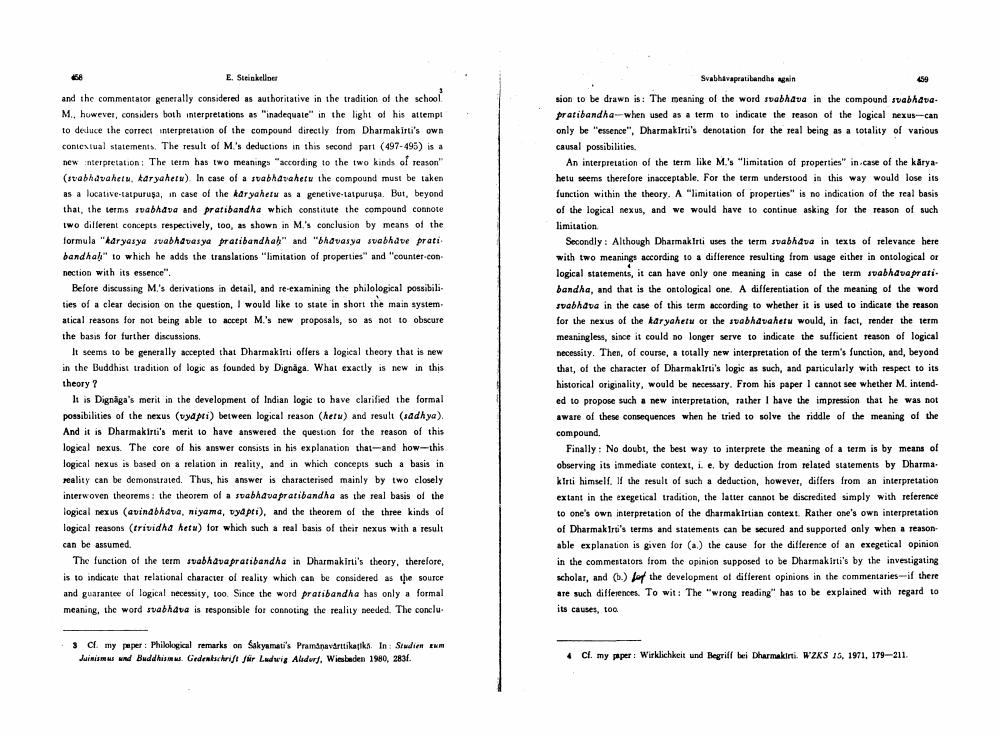Book Title: Svabhavarat Bandha Again Author(s): Ernat Steinkellner Publisher: Ernat Steinkellner View full book textPage 2
________________ E. Steinkeller and the commentator generally considered as authoritative in the tradition of the school M. however, considers both interpretations as "inadequate" in the light of his attempt to de luce the correct interpretation of the compound directly from Dharmakirti's own contextual statements. The result of M's deductions in this second part (497-495) is a new interpretation: The term has two meanings according to the two kinds of reason" (svabhavahetu, karya heru) In case of a stabharaheru the compound must be taken as a locative tatpurusa, in case of the kar yaheru as a genetive-Lalpurusa. But, beyond that, the terms svabhava and pratibandha which constitute the compound connote two dillerent concepts respectively, too, as shown in M.'s conclusion by means of the formula "karyasya sabhavasya pratibandhal" and "bhavasya sabhave prati bandhal" to which he adds the translations "limitation of properties" and "counter.com nection with its essence". Belore discussing M's derivations in detail, and re-examining the philological possibili ties of a clear decision on the question, I would like to state in short the main system atical reasons for not being able to accept M's new proposals, so as not to obscure the basis for further discussions, It seems to be generally accepted that Dharmakinti offers a logical theory that is new in the Buddhist tradition of logic as founded by Dignaga. What exactly is new theory? It is Dignāga's merit in the development of Indian logic to have clarified the formal possibilities of the nexus (vya pri) between logical reason (her) and result (sadhya). And it is Dharmakini's merit to have answered the question for the reason of this logical nexus. The core of his answer consists in his explanation that and how-this logical nexus is based on a relation in reality, and in which concepts such a basis in reality can be demonstrated. Thus, his answer is characterised mainly by two closely interwoven theorems: the theorem of a suabhava pratibandha as the real basis of the logical nexus (avinabhava, miyama, vydpei), and the theorem of the three kinds of logical reasons (trividha ketu) for which such a real basis of their nexus with a result can be assumed. The function of the term svabhava pratibandha in Dharmakirti's theory, therefore, is to indicate that relational character of reality which can be considered as the source and guarantee of logical necessity, too. Since the word praribandha has only a formal meaning, the word swabhava is responsible for connoting the reality needed. The conclu. Svabhavapratibandha again 159 sion to be drawn is: The meaning of the word svabhava in the compound svabhavapratibandha--when used as a term to indicate the reason of the logical nexus--can only be "essence". Dharmak Irti's denotation for the real being as a totality of vanous causal possibilities. An interpretation of the term like M's "limitation of properties" in case of the karya helu seems therefore inacceptable. For the term understood in this way would lose its function within the theory. A limitation of properties" is no indication of the real basis of the logical nexus, and we would have to continue asking for the reason of such limitation Secondly: Although Dharmakirti uses the term svabhava in texts of relevance here with two meanings according to a difference resulting from usage either in ontological or logical statements, it can have only one meaning in case of the term svabhava prati. bandha, and that is the ontological one. A differentiation of the meaning of the word svabhava in the case of this term according to whether it is used to indicate the reason for the nexus of the karyahetu or the sabhavahetu would, in fact, render the term meaningless, since it could no longer serve to indicate the sufficient reason of logical necessity. Then, of course, a totally new interpretation of the term's function, and, beyond that, of the character of Dharmakirui's logic as such, and particularly with respect to its historical originality, would be necessary. From his paper I cannot see whether M. intend ed to propose such a new interpretation, rather I have the impression that he was not aware of these consequences when he tried to solve the riddle of the meaning of the compound Finally: No doubt, the best way to interprete the meaning of a term is by means of observing its immediate context, ie, by deduction from related statements by Dharma kirti himself. I the result of such a deduction, however, differs from an interpretation extant in the exegetical tradition, the latter cannot be discredited simply with reference to one's own interpretation of the dharmak Irtian context. Rather one's own interpretation of Dharmak Irti's terms and statements can be secured and supported only when a reason able explanation is given for (a) the cause for the difference of an exegetical opinion in the commentators from the opinion supposed to be Dharmakirti's by the investigating scholar, and (b.) for the development of different opinions in the commentaries--if there are such differences. To wit: The "wrong reading has to be explained with regard to its causes, too actly is new in this o ch my paper : Philological remarks on Sakyamati's Pramanavar tikaika. In: Studien zum Juinismus und Buddhismus. Gedenkschrift fir Ludwig Alder). Wiesbaden 1980, 283f. 4 Cl. my paper : Wirklichkeit und Begriff bei Dharmakini. WzKS 15, 1971, 179-211.Page Navigation
1 2 3 4 5 6 7 8 9 10 11
